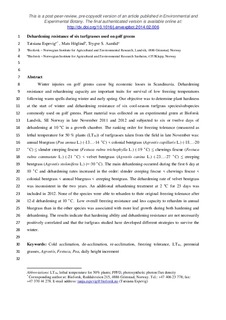| dc.contributor.author | Espevig, Tatsiana | |
| dc.contributor.author | Höglind, Mats | |
| dc.contributor.author | Aamlid, Trygve | |
| dc.date.accessioned | 2017-11-27T21:13:26Z | |
| dc.date.available | 2017-11-27T21:13:26Z | |
| dc.date.created | 2014-06-19T10:58:46Z | |
| dc.date.issued | 2014-02-20 | |
| dc.identifier.citation | Environmental and Experimental Botany. 2014, 106 182-188. | nb_NO |
| dc.identifier.issn | 0098-8472 | |
| dc.identifier.uri | http://hdl.handle.net/11250/2468179 | |
| dc.description.abstract | Winter injuries on golf greens cause big economic losses in Scandinavia. Dehardening resistance and rehardening capacity are important traits for survival of low freezing temperatures following warm spells during winter and early spring. Our objective was to determine plant hardiness at the start of winter and dehardening resistance of six cool-season turfgrass species/subspecies commonly used on golf greens. Plant material was collected on an experimental green at Bioforsk Landvik, SE Norway in late November 2011 and 2012 and subjected to six or twelve days of dehardening at 10 °C in a growth chamber. The ranking order for freezing tolerance (measured as lethal temperature for 50% plants (LT50)) of turfgrasses taken from the field in late November was: annual bluegrass (Poa annua L.) (−13 to −14 °C) < colonial bentgrass (Agrostis capillaris L.) (−18 to −20 °C) ≤ slender creeping fescue (Festuca rubra trichophylla L.) (−19 °C) ≤ chewings fescue (Festuca rubra commutate L.) (−21 °C) < velvet bentgrass (Agrostis canina L.) (−23 to −27 °C) ≤ creeping bentgrass (Agrostis stolonifera L.) (<−30 °C). The main dehardening occurred during the first 6 days at 10 °C and dehardening rates increased in the order: slender creeping fescue < chewings fescue < colonial bentgrass < annual bluegrass < creeping bentgrass. The dehardening rate of velvet bentgrass was inconsistent in the two years. An additional rehardening treatment at 2 °C for 23 days was included in 2012. None of the species were able to reharden to their original freezing tolerance after 12-d dehardening at 10 °C. Low overall freezing resistance and less capacity to reharden in annual bluegrass than in the other species was associated with more leaf growth during both hardening and dehardening. The results indicate that hardening ability and dehardening resistance are not necessarily positively correlated and that the turfgrasses studied have developed different strategies to survive the winter. | nb_NO |
| dc.language.iso | eng | nb_NO |
| dc.publisher | Elsevier | nb_NO |
| dc.rights | Attribution-NonCommercial-NoDerivatives 4.0 Internasjonal | * |
| dc.rights.uri | http://creativecommons.org/licenses/by-nc-nd/4.0/deed.no | * |
| dc.subject | Cold acclimation | nb_NO |
| dc.subject | de-acclimation | nb_NO |
| dc.subject | re-acclimation | nb_NO |
| dc.subject | freezing tolerance | nb_NO |
| dc.title | Dehardening resistance of six turfgrasses used on golf greens | nb_NO |
| dc.type | Journal article | nb_NO |
| dc.type | Peer reviewed | nb_NO |
| dc.description.version | acceptedVersion | nb_NO |
| dc.rights.holder | Copyright © 2014 Elsevier B.V. All rights reserved. | nb_NO |
| dc.source.pagenumber | 182-188 | nb_NO |
| dc.source.volume | 106 | nb_NO |
| dc.source.journal | Environmental and Experimental Botany | nb_NO |
| dc.identifier.doi | 10.1016/j.envexpbot.2014.02.006 | |
| dc.identifier.cristin | 1139070 | |
| dc.relation.project | Norges forskningsråd: 208010 | nb_NO |
| dc.relation.project | Egen institusjon: 190010 | nb_NO |
| cristin.ispublished | true | |
| cristin.fulltext | postprint | |
| cristin.qualitycode | 1 | |

